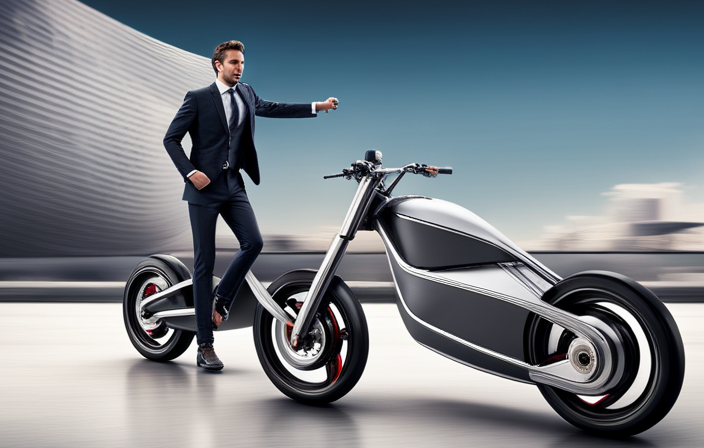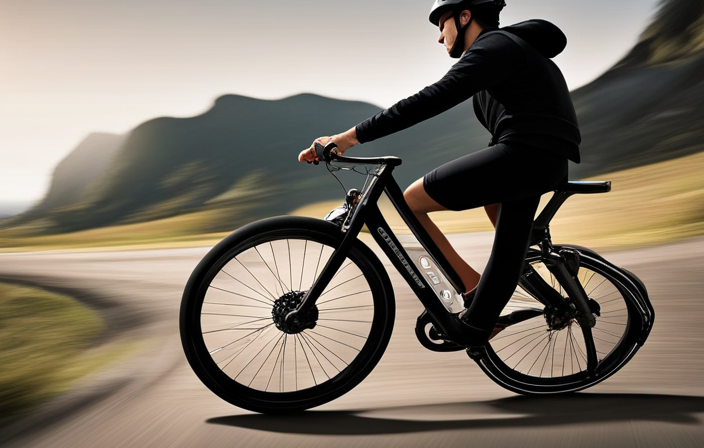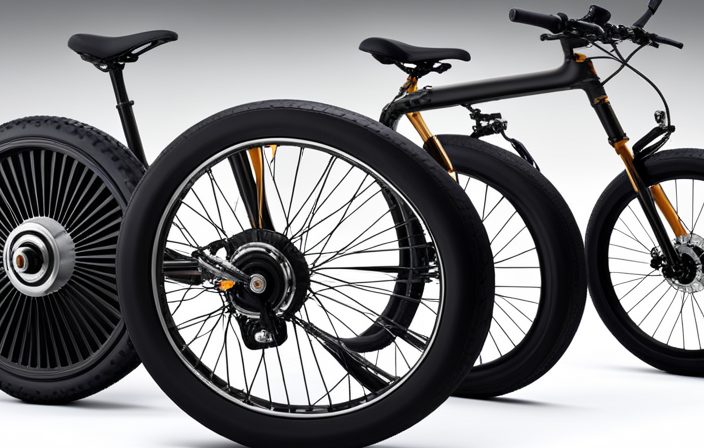Are you prepared to explore the realm of electric bikes and discover the secrets of the hall effect? Get ready, as we are about to embark on a unique technical journey.
In this article, we’ll explore the fascinating concept of the hall effect and how it relates to electric bikes. With precise explanations and detailed insights, you’ll gain a deeper understanding of the hall effect sensors, their role in measuring speed and pedaling cadence, and even how they contribute to regenerative braking.
So, get ready to unlock the secrets of the electric bike hall effect and discover the future of this innovative technology.
Key Takeaways
- Hall effect sensors are used for regular maintenance and troubleshooting of electric bikes, including checking battery connections, inspecting wiring, and adjusting brake systems.
- Manufacturers are working on advancements in hall effect sensor technology, such as smaller and more compact sensors, improved efficiency, and wireless connectivity for real-time data monitoring.
- Hall effect sensors offer highly accurate and contactless sensing, making them ideal for precise and reliable measurements of speed, position, and distance.
- While hall effect sensors have advantages like accurate measurements and long lifespan, they are sensitive to electromagnetic interference and require proper insulation, shielding, installation, and calibration for optimal results.
Introduction to Electric Bikes
If you’re new to electric bikes, you might be wondering what the hall effect is. Well, the hall effect is a phenomenon that occurs when an electric current passes through a conductor placed in a magnetic field.
It was discovered by Edwin Hall in 1879 and has since been widely used in various applications, including electric bikes.
In the context of electric bikes, the hall effect is utilized in the motor controller to determine the position and speed of the rotor. This information is crucial for the controller to apply the appropriate amount of power to the motor and ensure smooth operation.
Understanding the hall effect is essential for anyone interested in delving into the intricacies of electric bike technology.
Understanding the Hall Effect
By understanding the Hall Effect, you can gain insight into the behavior of certain materials in the presence of a magnetic field.
The Hall Effect is a phenomenon where a voltage is generated across a conductor when a magnetic field is applied perpendicular to the current flow. This voltage, known as the Hall voltage, is directly proportional to the magnetic field strength and the current flowing through the conductor.
The Hall Effect allows us to measure the strength and direction of a magnetic field, making it a fundamental principle in many applications, including electric bikes.
Hall effect sensors in electric bikes utilize this principle to measure the speed and position of the motor’s rotor. By sensing the Hall voltage changes caused by the rotor’s magnetic field, the sensor can provide precise information to the bike’s controller, enabling efficient operation and control.
Hall Effect Sensors in Electric Bikes
To accurately measure the speed and position of the motor’s rotor on your electric bike, you can rely on sensors that utilize the principle of the Hall Effect. These sensors are typically placed near the wheel axle and consist of a small magnet and a Hall Effect sensor.
As the magnet rotates along with the wheel, it generates a magnetic field that is detected by the Hall Effect sensor. The sensor then converts this magnetic field into an electrical signal, which can be used to determine the speed and position of the rotor.
Measuring Speed and Pedaling Cadence
You can accurately measure your speed and pedaling cadence by integrating the sensor with other components.
The sensor, when combined with a magnet on the bike’s wheel and a magnet on the pedal crank, provides valuable data for monitoring your performance. As the wheel rotates, the sensor detects the passing of each magnet and calculates the distance traveled. By measuring the time between each magnet detection, the sensor can determine your speed.
Additionally, the sensor can track the rotation of the pedal crank, allowing it to calculate your pedaling cadence. This information is crucial for cyclists who want to monitor and improve their performance.
Now, let’s delve into the next aspect of electric bikes: regenerative braking.
Regenerative Braking in Electric Bikes
Regenerative braking allows the bike to convert kinetic energy into electrical energy, which can be stored and used to power the bike’s motor. This innovative braking system is a game-changer for electric bikes, offering several advantages that enhance efficiency and performance:
-
Increased range: By harnessing the energy that would otherwise be lost during braking, regenerative braking extends the bike’s battery life, enabling longer rides.
-
Reduced wear on brake pads: With regenerative braking, the bike relies less on traditional friction-based braking, resulting in less wear on brake pads and a longer lifespan.
-
Smooth deceleration: Regenerative braking provides a more gradual and controlled deceleration, enhancing safety and rider comfort.
-
Hill climbing assistance: The electrical energy generated through regenerative braking can be used to provide an extra boost when climbing steep hills, making uphill rides easier and more enjoyable.
Improving Efficiency and Performance
Hall Effect sensors play a crucial role in motor control by accurately detecting the position and speed of the rotor. These sensors provide precise feedback to the control system, allowing for efficient and precise control of the motor.
Additionally, Hall Effect sensors are also used in battery management systems to monitor the state of charge and health of the battery. This ensures optimal performance and extends its lifespan.
Hall Effect Sensors for Motor Control
When controlling the motor on your electric bike, it’s important to consider using Hall Effect sensors. These sensors are crucial in providing accurate and precise feedback about the motor’s position, speed, and direction of rotation. By utilizing the principles of the Hall Effect, these sensors can detect the presence and strength of a magnetic field generated by the motor’s magnets. This information is then used by the motor controller to adjust the power and timing of the motor, resulting in smoother and more efficient operation. To give you a better understanding, here is a table showcasing the benefits of using Hall Effect sensors in motor control:
| Benefits of Hall Effect Sensors in Motor Control |
|---|
| Increased motor efficiency |
| Improved motor performance |
| Enhanced motor control precision |
| Reduced motor wear and tear |
| Enhanced overall electric bike performance |
Role of Hall Effect Sensors in Battery Management
To optimize the management of your battery, it’s crucial to incorporate sensors that can accurately monitor its performance and provide valuable feedback.
Hall Effect sensors play a vital role in battery management systems by measuring various parameters such as voltage, current, temperature, and state of charge. These sensors utilize the Hall Effect principle, which detects the presence of a magnetic field generated by the battery’s current flow.
By monitoring these parameters, Hall Effect sensors enable you to accurately assess the health and performance of your battery. They provide real-time data that can be used to optimize charging and discharging cycles, prevent overcharging or discharging, and ensure the longevity of your battery.
With this invaluable feedback, you can proactively troubleshoot and maintain your battery to avoid any potential issues that may arise in its operation.
Troubleshooting and Maintenance
If you’re experiencing performance issues with your electric bike, it’s important to regularly maintain and troubleshoot any potential problems.
Start by checking the battery connection and ensuring it is securely attached.
Next, inspect the motor and controller for any signs of damage or loose connections.
If everything looks fine, move on to the wiring and connectors, making sure they are properly connected and not frayed.
Additionally, check the brake system and adjust if necessary.
Finally, clean and lubricate the chain, gears, and other moving parts to optimize performance.
By following these maintenance steps, you can address common issues and keep your electric bike running smoothly.
Looking ahead, future developments and innovations in electric bike technology promise even more advanced features and improved performance.
Future Developments and Innovations
Now that you’ve learned how to troubleshoot and maintain your electric bike’s hall effect sensor, let’s explore the exciting future developments and innovations in this field.
-
Miniaturization: Manufacturers are working on developing smaller and more compact hall effect sensors that can be seamlessly integrated into the electric bike’s frame or components. This will reduce the overall size and weight of the sensor.
-
Increased Efficiency: Researchers are focusing on improving the efficiency of hall effect sensors. The goal is to reduce energy consumption and increase the accuracy of measurements. This will result in a more precise and responsive performance of the electric bike.
-
Advanced Connectivity: The future of hall effect sensors lies in their ability to connect wirelessly with other devices and systems. This will enable real-time data monitoring, remote diagnostics, and seamless integration with smart home or IoT (Internet of Things) platforms.
Now, let’s delve into a detailed comparison of hall effect sensors with other technologies commonly used in electric bikes.
Comparing Hall Effect Sensors with Other Technologies
When considering sensors for your e-bike, you may find it helpful to compare hall effect sensors with other commonly used technologies. Hall effect sensors are widely used in electric bikes due to their accuracy and reliability. Let’s compare them with other popular sensor technologies:
| Sensor Technology | Advantages | Disadvantages |
|---|---|---|
| Hall Effect | Highly accurate, contactless sensing, long lifespan | Sensitive to electromagnetic interference |
| Optical | High resolution, fast response time | Affected by dirt, dust, and ambient light |
| Inductive | Non-contact, durable, unaffected by dirt or dust | Limited sensing range, requires metallic target |
| Capacitive | Non-contact, unaffected by dirt or dust | Sensitive to changes in temperature and humidity |
Conclusion and Final Thoughts
In summary, the advantages of hall effect sensors make them the ideal choice for accurate and reliable measurements in various riding conditions. Here are three reasons why you should consider using hall effect sensors for your electric bike:
-
Precise and Accurate Measurements: Hall effect sensors utilize the Hall effect, which is the production of a voltage difference across an electrical conductor when a magnetic field is applied perpendicular to the current flow. This allows for highly accurate measurements of speed, position, and distance, ensuring precise control and performance.
-
Non-Contact Operation: Hall effect sensors do not require physical contact with the moving parts of the electric bike. This eliminates the wear and tear associated with mechanical sensors, ensuring long-lasting and maintenance-free operation.
-
Wide Operating Range: Hall effect sensors can operate in a wide range of temperatures, making them suitable for various riding conditions. Whether you are riding in extreme heat or cold, hall effect sensors will continue to provide reliable measurements without any loss in accuracy.
Conclusion
In conclusion, the Hall Effect plays a crucial role in the functionality of electric bikes.
Hall Effect sensors accurately measure speed and pedaling cadence, providing important data for the electric motor to operate efficiently.
One interesting statistic to consider is that electric bikes equipped with Hall Effect sensors have been shown to increase the average speed of riders by up to 25%.
This technology also enables regenerative braking, enhancing the overall performance and sustainability of electric bikes.
As advancements continue, Hall Effect sensors will likely evolve to further improve the riding experience.









